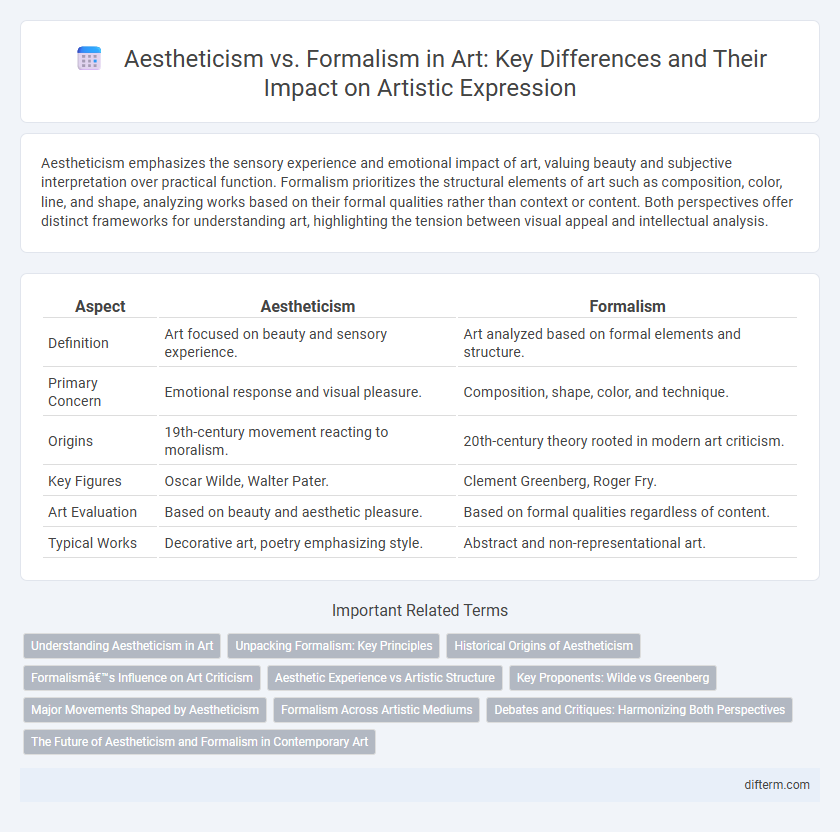Aestheticism emphasizes the sensory experience and emotional impact of art, valuing beauty and subjective interpretation over practical function. Formalism prioritizes the structural elements of art such as composition, color, line, and shape, analyzing works based on their formal qualities rather than context or content. Both perspectives offer distinct frameworks for understanding art, highlighting the tension between visual appeal and intellectual analysis.
Table of Comparison
| Aspect | Aestheticism | Formalism |
|---|---|---|
| Definition | Art focused on beauty and sensory experience. | Art analyzed based on formal elements and structure. |
| Primary Concern | Emotional response and visual pleasure. | Composition, shape, color, and technique. |
| Origins | 19th-century movement reacting to moralism. | 20th-century theory rooted in modern art criticism. |
| Key Figures | Oscar Wilde, Walter Pater. | Clement Greenberg, Roger Fry. |
| Art Evaluation | Based on beauty and aesthetic pleasure. | Based on formal qualities regardless of content. |
| Typical Works | Decorative art, poetry emphasizing style. | Abstract and non-representational art. |
Understanding Aestheticism in Art
Aestheticism in art emphasizes the pursuit of beauty and sensory experience over practical function or narrative content, prioritizing visual pleasure and emotional impact. This movement values the intrinsic qualities of colors, shapes, and compositions, advocating for art to be appreciated as an autonomous experience. Understanding Aestheticism involves recognizing its rejection of moral or political themes, focusing instead on art's capacity to evoke a pure, refined aesthetic response.
Unpacking Formalism: Key Principles
Formalism in art emphasizes the analysis of visual elements such as line, color, shape, and texture to evaluate a work's meaning and aesthetic value independently of context or content. Key principles include the prioritization of form over subject matter, the belief that the artwork's structure and composition evoke emotional or intellectual responses. This approach supports the idea that the intrinsic qualities of the artwork itself, rather than external references, hold the key to understanding its artistic merit.
Historical Origins of Aestheticism
Emerging in the late 19th century, Aestheticism originated as a reaction against Victorian moralism, emphasizing "art for art's sake" and the pursuit of beauty independent of practical function or social themes. Key figures such as Oscar Wilde and Walter Pater championed the movement, promoting sensory experience and the intrinsic value of artistic expression. This philosophy contrasted sharply with Formalism, which prioritized structural elements like composition and technique over emotional or decorative qualities.
Formalism’s Influence on Art Criticism
Formalism's influence on art criticism centers on the emphasis of compositional elements such as line, color, shape, and texture over contextual or narrative content. This approach prioritizes an artwork's intrinsic features, encouraging critics to assess aesthetic value based on form alone, which revolutionized traditional interpretation methods. The formalist perspective fosters a more objective and systematic framework for analyzing visual art, highlighting craftsmanship and design principles.
Aesthetic Experience vs Artistic Structure
Aestheticism emphasizes the sensory and emotional experience elicited by art, prioritizing beauty and the viewer's personal response. Formalism centers on analyzing artistic structure, such as composition, color, and technique, highlighting how these elements contribute to the work's meaning. The tension between aesthetic experience and artistic structure reveals differing approaches to interpreting visual art, where feeling contends with form.
Key Proponents: Wilde vs Greenberg
Oscar Wilde championed Aestheticism by emphasizing art's intrinsic beauty and the principle of "art for art's sake," rejecting moral or social utility. Clement Greenberg advanced Formalism through his critical analysis of modernist painting, focusing on medium-specific qualities like flatness and color rather than narrative content. These contrasting approaches highlight Wilde's advocacy for sensory experience against Greenberg's prioritization of structural purity in visual art.
Major Movements Shaped by Aestheticism
The Aestheticism movement, emphasizing art for art's sake, profoundly influenced major 19th-century artistic developments such as the Pre-Raphaelite Brotherhood and Art Nouveau, which prioritize beauty, sensory experience, and decorative detail over narrative content. This movement challenged formalist approaches by rejecting strict adherence to compositional rules and technical precision, instead valuing individual expression and visual pleasure. Key figures like Oscar Wilde and Aubrey Beardsley exemplify Aestheticism's impact on shaping distinctive styles that celebrate artistic autonomy and the evocative power of aesthetics.
Formalism Across Artistic Mediums
Formalism emphasizes the intrinsic formal elements of artworks such as line, color, shape, and texture, prioritizing composition over narrative or emotional content. This approach manifests across artistic mediums including painting, sculpture, music, and literature, highlighting structural harmony and balance. Critical analysis rooted in formalism evaluates how these elements create unity and evoke aesthetic appreciation independent of context or symbolism.
Debates and Critiques: Harmonizing Both Perspectives
Aestheticism emphasizes the sensory and emotional experience of art, celebrating beauty and style as essential components, while Formalism prioritizes structural elements such as composition, color, and technique to evaluate artistic merit. Debates between proponents highlight the challenge of balancing subjective appreciation with objective analysis, questioning whether emotional impact or formal qualities more accurately define artistic value. Harmonizing both perspectives fosters a comprehensive critique that respects the artwork's technical mastery and its capacity to evoke profound aesthetic responses.
The Future of Aestheticism and Formalism in Contemporary Art
The future of Aestheticism in contemporary art emphasizes sensory experience and emotional resonance, prioritizing beauty and subjective interpretation over strict adherence to form. Formalism continues to influence art by advocating for the analysis of compositional elements such as line, color, and texture, reinforcing the importance of structure and technique. Emerging trends blend both perspectives, encouraging artists to balance aesthetic appeal with formal rigor in innovative and contextually relevant ways.
Aestheticism vs Formalism Infographic

 difterm.com
difterm.com